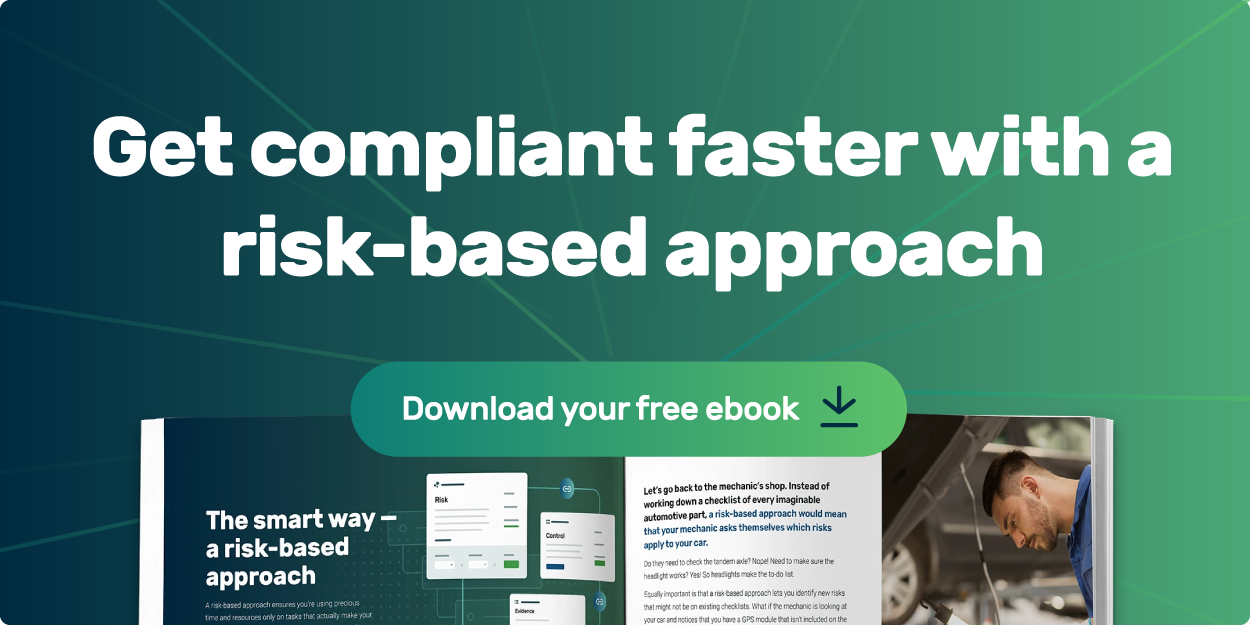Whether your business is private or public, state or federal, or for- or non-profit, you’re exposed to compliance risk — and you should take it seriously. If you don’t, you could find yourself sure that on the wrong side of laws and regulations, hurting your reputation, revenue, valuation, and business opportunities.
What is compliance risk?
Compliance risk — also known as integrity risk — refers to the financial, legal, reputational, or business impact of not adhering to a set of standards, laws, frameworks, regulations, internal policies, and/or prescribed best practices on an organization of any size or structure. In other words, it’s a business’s risk of exposure to material loss, financial fines, and/or legal penalties for not complying with privacy or other security regulations.
Compliance risk is a broad term, so it can be helpful to understand some of the common types of risk that you may encounter:
Security or fraud risk
This refers to any event where persons internal or external to the organization cause harm through deliberate deception. It can include the violation of privacy laws due to breaches caused by phishing, infiltration, viruses, malware, and other malicious hacking tactics. Thankfully, a penetration test can help your business safeguard itself from such attacks.
Process or regulatory risk
This is the result of failure to comply with laws and regulations, lack of adherence to an established procedure, and/or deviation from a standard process. Process or regulatory risk could include a failure to safeguard protected health information (PHI) per Health Insurance Portability and Accountability Act (HIPAA) guidelines or not inadequate measures to mitigate regulatory risk in accordance with the General Data Protection Regulation (GDPR).
Legal or compliance risk
This can be any situation in which an organization’s actions violate state, local, or federal laws or regulations, and it can include illegal practices like theft, money laundering, fraud, bribery, or embezzlement. Such practices may be a result of product liability, security breaches, or illegal actions taken by employees.
To learn more about different types of risk, read this.
What is compliance risk management?
Compliance risk management is a set of management processes that aims to identify, assess, address, and monitor compliance risks. Following these processes mitigates a company’s potential losses that may arise from noncompliance with standards, laws, regulations, and both internal and external policies and procedures.
Compliance risk management should be a continuous process that involves reviewing compliance policies, procedures, and training materials on a regular basis. And, since new regulations, policies, and directives are constantly being introduced — and current ones are being updated and revised — continuously tracking changes in the regulatory environment can ensure an organization's compliance is up to date.

Risks of non-compliance
We already mentioned it, but it’s worth emphasizing again — non-compliance often results in a loss of reputation, revenue, valuation, and business opportunities. That’s because compliance risk extends to all levels of the organization.
The first step in ensuring compliance risk is properly managed is to consider how noncompliance could affect the various aspects of your business:
- Financial: Impacts to the bottom line, such as investor confidence or share price
- Legal: Fines, penalties, and even jail time
- Business: Impact to operations or people management
- Reputational: How the organization is perceived in the marketplace
Important elements of a compliance risk management program
If you’re ready to get your compliance risk management program off on the right foot, it’s important to consider risks across the organization, including assets. Start by thinking through who will participate in the process and how, the frequency with which risks will be reassessed, and how results will be reported.
Typically run by a compliance manager, risk officer, or chief compliance officer (CCO), a strong risk management program will incorporate both quantitative and qualitative measures, assign risk ownership, have a well defined risk treatment process, and continuously monitor risks.
Following the standards set forth by popular compliance frameworks — like ISO 27001, HIPAA, GDPR, CCPA, NIST, and SOC 2, among others — can help your organization ensure that compliance risk is managed properly from the start.
The first step will be to conduct a risk assessment, in which potential risks that threaten your organization's ability to ensure compliance with laws and regulations are identified, assessed, and prioritized. This will include looking at your assets, people, and IT environment to understand weaknesses where they are exposed and identify threats that could exploit those vulnerabilities.
The goal of the risk assessment is to uncover the information necessary to reduce the risk of potentially damaging events in the future and to identify changes that need to be made in order to further improve compliance.
Don’t forget: This is not a one-time thing. It’s important to regularly conduct risk assessments in order to be proactive in your risk mitigation efforts.
Right-sizing compliance risk management with Strike Graph
If you’re ready to ensure you have a thorough compliance risk management program, then Strike Graph can help. Our compliance operation and certification platform distributes responsibility for compliance across your whole team, making the process easier and more sustainable. Strategic automation means you only have to work on the tasks that actually require a human touch. And because Strike Graph supports multiple certifications, the work you do today will pay off as you pursue other certifications in the future.
When it comes to compliance risk management, the earlier you start, the better. Starting when your company is small helps you avoid running into problems as your headcount and organizational footprint expand. And most importantly, you build trust and drive revenue growth, by proving that your technological infrastructure — and the information it contains — is safe from the start.
.jpg?width=1448&height=726&name=Screen%20Shot%202023-02-09%20at%202.57.5-min%20(1).jpg)







.webp?width=600&height=600&name=image%20(7).webp)


